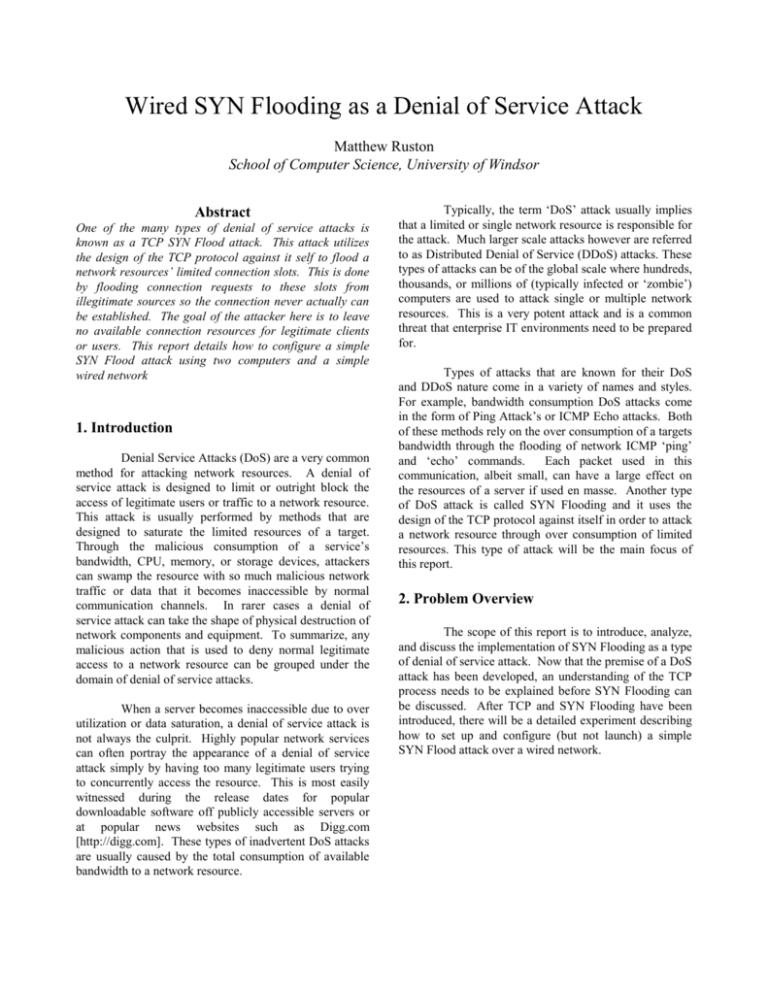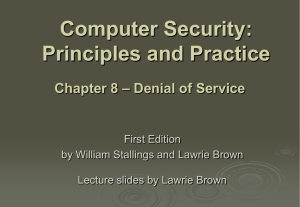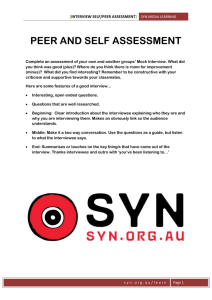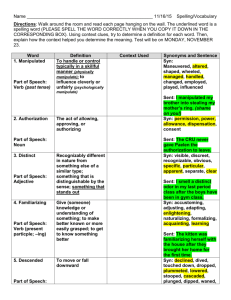Wired SYN Flooding as a DoS Attack
advertisement

Wired SYN Flooding as a Denial of Service Attack Matthew Ruston School of Computer Science, University of Windsor Abstract One of the many types of denial of service attacks is known as a TCP SYN Flood attack. This attack utilizes the design of the TCP protocol against it self to flood a network resources’ limited connection slots. This is done by flooding connection requests to these slots from illegitimate sources so the connection never actually can be established. The goal of the attacker here is to leave no available connection resources for legitimate clients or users. This report details how to configure a simple SYN Flood attack using two computers and a simple wired network 1. Introduction Denial Service Attacks (DoS) are a very common method for attacking network resources. A denial of service attack is designed to limit or outright block the access of legitimate users or traffic to a network resource. This attack is usually performed by methods that are designed to saturate the limited resources of a target. Through the malicious consumption of a service’s bandwidth, CPU, memory, or storage devices, attackers can swamp the resource with so much malicious network traffic or data that it becomes inaccessible by normal communication channels. In rarer cases a denial of service attack can take the shape of physical destruction of network components and equipment. To summarize, any malicious action that is used to deny normal legitimate access to a network resource can be grouped under the domain of denial of service attacks. When a server becomes inaccessible due to over utilization or data saturation, a denial of service attack is not always the culprit. Highly popular network services can often portray the appearance of a denial of service attack simply by having too many legitimate users trying to concurrently access the resource. This is most easily witnessed during the release dates for popular downloadable software off publicly accessible servers or at popular news websites such as Digg.com [http://digg.com]. These types of inadvertent DoS attacks are usually caused by the total consumption of available bandwidth to a network resource. Typically, the term ‘DoS’ attack usually implies that a limited or single network resource is responsible for the attack. Much larger scale attacks however are referred to as Distributed Denial of Service (DDoS) attacks. These types of attacks can be of the global scale where hundreds, thousands, or millions of (typically infected or ‘zombie’) computers are used to attack single or multiple network resources. This is a very potent attack and is a common threat that enterprise IT environments need to be prepared for. Types of attacks that are known for their DoS and DDoS nature come in a variety of names and styles. For example, bandwidth consumption DoS attacks come in the form of Ping Attack’s or ICMP Echo attacks. Both of these methods rely on the over consumption of a targets bandwidth through the flooding of network ICMP ‘ping’ and ‘echo’ commands. Each packet used in this communication, albeit small, can have a large effect on the resources of a server if used en masse. Another type of DoS attack is called SYN Flooding and it uses the design of the TCP protocol against itself in order to attack a network resource through over consumption of limited resources. This type of attack will be the main focus of this report. 2. Problem Overview The scope of this report is to introduce, analyze, and discuss the implementation of SYN Flooding as a type of denial of service attack. Now that the premise of a DoS attack has been developed, an understanding of the TCP process needs to be explained before SYN Flooding can be discussed. After TCP and SYN Flooding have been introduced, there will be a detailed experiment describing how to set up and configure (but not launch) a simple SYN Flood attack over a wired network. 3. Overview of Transmission Control Protocol (TCP) The transmission control protocol is a huge fundamental technology standard that powers networks all around the globe. TCP works through a system of ‘handshake’ mechanisms that are used to construct a reliable connection between two communicating network nodes. TCP is considered ‘reliable’ because it requires the recipient to acknowledge to the sender that each packet - although potentially out of order - is received. Before the transfer of data can be performed, first the TCP protocol needs to set up a connection between two resources. This is done through the three step TCP handshake process. The TCP handshake process occurs as follows: Client A wishes to establish a TCP connection to Client B. 1. 2. 3. Client A sends a TCP-SYN packet to Client B. If Client B receives the TCP-SYN packet then Client B sends a TCP-SYN-ACK packet to Client A. Client B waits for Client A to send a TCP-ACK packet to Client B in response to the TCP-SYNACK message sent by Client B. 4. SYN Flood Denial of Service Attacks A SYN Flood DoS attack utilizes an excessive number of TCP SYN packet requests to the target server in order to perform the attack. When a resource receives a SYN request it will create a ‘half open’ connection and then send out a SYN-ACK message to the originating source address in the SYN packet. The attack occurs when the source address has been forged and no actual ACK response from the source (thus completing the three way TCP handshake) ever occurs. This leaves the target node waiting for a specific amount of time (as set on the network resource) waiting for the ACK response that will never arrive. When repeated over time, this causes the attacked node create numerous of these half open connections that are just idling and waiting for the ACK response that will never arrive. Eventually these half open connections will time out naturally, but the goal of a SYN Flood is to then immediately reacquire the connection slot once it has timed out. If all of the possible connection slots can be saturated by the attacker then no legitimate traffic will be able to connect to or use the target resource. Providing the SYN Flood is sustained by the attacker and no counter-measures are configured or used on the target machine, a sustained SYN Flood attack could theoretically cause a DoS state on the target machine for an indefinite amount of time. Figure 2 SYN Flood Example Figure 1 TCP Handshake Process Once this connection process has been completed, the two clients will be able to transfer messages, in the form of packets, between each other. Each time Client A sends a packet to Client B, Client B will acknowledge receipt of that packet with a ACK message to Client A, and vice versa. As seen in Figure 3, an example of a simple SYN Flood attack, an attacker (as defined by the character with the sunglasses) sends a number of SYN requests to a target. The target sends back an appropriate number of SYN-ACK requests and waits for the responses. Since the attacker forged the source addresses of the originating packets the SYN-ACK will have no valid location to go to and thus, the half-open connection on the target resource never receives the ACK request that it is waiting for. This ties up valid connection resources and prevents legitimate traffic (as defined by the female character on the diagram) from connecting to the network resource. Thus the resource has been denied to a non-malicious user. capabilities that allow users to capture and view packets in real time across a multitude of network protocols. For this experiment, Wireshark was used on the target machine to analyze the incoming and outgoing network traffic. 5. Configuring and Building a Wired SYN Flood Attack NMap is an open-source and freely available network analysis tool. NMap’s features include port scanning, operating system detection and host discovery, among others. For the scope of the experiment the command line Windows version of the software was used by the attacker. The steps in order to set up a wired SYN Flood attack will now be detailed. Note that no actual SYN Flood attack will be launched through the scope of this report. 5.1 Equipment The equipment used for the configuration of a SYN Flood attack was the following. - 1 Laptop (ATTACKER) AMD Sempron 3000+ (1.80GHz) CPU, 384MB RAM. Realtek RTL8139/810x Family Fast Ethernet NIC (10/100Mbs) Windows XP SP2 1 Desktop PC (TARGET) Intel Pentium 4 2.00GHz CPU, 768MB RAM. SIS 900-Based PCI Fast Ethernet Adapter (10/100Mbs) Windows XP SP2 1 D-Link DI-624 Wireless Router/Switch Configured for DHCP on 192.168.0.* subnet TARGET PC configured to reside in demilitarized zone (DMZ) through the router. This was to prevent the firewall software on the DI-624 from effecting or filtering the attack. The attacker and target nodes were connected through the router and automatically assigned IP’s via the DHCP protocol running on the device. 5.2 Software Applications The following free software applications were used in the process of configuring the SYN Flood attack. 5.2.1 Wireshark Free software network protocol analyzer. This multiplatform application comes bundled with a GUI to make network troubleshooting and analysis easy on the eyes. It is most often used for its packet sniffing 5.2.2 NMAP (“Network Mapper”) 5.2.3 Engage Packet Builder Engage is a Windows platform GUI application that allows the construction of packets starting from the link layer of the OSI Network Model Standard. It allows users to create IMCP, TCP and UDP packets and send them to any IP or MAC address that they wish. It also supports the spoofing of sender MAC and IP addresses. This software is used to launch the actual attack against the target machine. 5.3 Attack Configuration The first step when preparing the attack is to determine an available host and an open port on that host to attack. An open TCP port is required so the SYN packets can be sent to the port and actually accepted. Sending a SYN packet to a closed port will not result in an effective denial of service attack. It was predetermined that the IP of the target machine was 192.168.0.105. Next, from the attacking machine, NMap was used to determine open TCP ports on the target. This was done using the following NMap parameters: > nmap –sS 192.168.0.105 Which gave the following results: Figure 3 NMap Results Starting Nmap 4.20 ( http://insecure.org ) at 2007-10-20 16:37 Eastern Daylight Time Interesting ports on 192.168.0.105: Not shown: 1694 closed ports PORT STATE SERVICE 135/tcp open msrpc 139/tcp open netbios-ssn 445/tcp open microsoft-ds MAC Address: 00:15:F2:72:D4:4C (Asustek Computer) Nmap finished: 1 IP address (1 host up) scanned in 2.422 seconds From this report it was determined that port 139 would be a good port to attack. Port 139 is the Windows NetBOIS Session port. It is used by Windows File and Printer Sharing. This port will often have activity in a network where Windows-based machines are actively sharing printers and files. Thus this port serves as a good target point for attacking. If a successful SYN Flood is launched against this port Windows File and Printer Sharing service should theoretically begin to malfunction and cause a DoS environment. Figure 5 Engage Packet Builder Screenshot Now that a target machine and a target port have been identified it is now time to configure custom TCP packets in order to perform the attack. The goal here is to construct simple TCP-SYN packets and to forge the source address to the target keeps a half-open connection reserved for the malicious TCP handshake that will never complete. Engage Packet Builder is used by the attacker to construct and send the packets to the target machine. The following options were used to construct the packet Figure 4 Engage Packet Builder Configuration Network Interface: Realtek RTL8139/810x Family Fast Ethernet NIC Source IP: 33.66.66.110 Source Port: 80 Destination IP: 192.168.0.105 Destination Port: 139 Header Size: 28 bytes Type of Service: Routine Specify Total Length: 40 Fragmentation DF: 0 (May Fragment) Fragmenttation MF: 0 (Last Fragment) TTL : 64 Sequence : 0, Ackknowledge : 0 Flags : SYN Nb of Packets : 10000, Packet Type : TCP As it can be seen from the Engage Packet Builder configuration, the source (attacker’s) address has been spoofed with an alternative address. The attacker’s address in this scenario is really 192.168.0.100 – an internal DHCP assigned address – but the target is being directed to a random IP location that exists outside of the private network. In reality, the spoofed source address is not even an actual responding server (tested via NMap). So there is no possible way for the spoofed address to actually send back the ACK packet to complete the TCP handshake. To actually create the SYN packet to be sent, all that was required was to set the ‘SYN’ flag in the builder to ‘true’. To increase the network traffic caused by the SYN packets a 28 byte header size was used. This also allows the crafted packets to appear more legitimate. When wishing to perform the actual attack a vastly large amount of packets need to be sent. Thus Engage Packet Builder was configured to send 10 000 of the specifically designed packet in order to invoke the attack. One client of Engage Packet Builder might not necessarily be enough in order to witness the effects of a DoS occurrence however. To increase the potency of the attack multiple instances of Engage Packet Builder could be initiated. Each of these instances could then be configured to send a certain amount of packets to a specific port from any spoofed attacker address. This could greatly increase the amount of malicious traffic to the target network resource. 6.0 Conclusion and Prevention Techniques This report introduced the concepts behind denial of service attacks and then went into detail on the specific type of DoS attack known as SYN Flooding. By knowing how a SYN Flood works and how to construct one, network security personal can be better prepared to intercept and deal with their occurrence. Since the conception of the SYN Flood DoS idea there has been developments into the design of networks and operating systems in order to prevent or limit their occurrence. For example, an operating system could be designed to only accept a certain number of TCP-SYN requests from a single host during a specific time frame. Another countermeasure is called SYN Cookies. This strategy allows certain half-open TCP connections to be set aside when the TCP-SYN queue fills. As more TCP SYN requests enter the system the ones that were set aside (due to the lack of a SYN-ACK) will eventually time out while not actually tying up a critical and limited resource on the machine. This method effectively expands the amount of SYN requests that a resource can handle at any given time. Although these counter-measures have been implemented in many systems to combat SYN Flood attacks it is still important to understand the concept of SYN Flooding. By understanding this DoS example security professionals will be better prepared to identify and respond to future attacks. 7.0 References [Figure 1] Tcp_normal.png. Author: Drake [http://en.wikipedia.org/wiki/Image:Tcp_normal.png]. Used under Creative Commons Attribution ShareAlike 2.5 license. Accessed October 28, 2007 [Figure 2] Tcp_synflood.png. Author: Drake [http://en.wikipedia.org/wiki/Image:Tcp_synflood.png]. Used under Creative Commons Attribution ShareAlike 2.5 license. Accessed October 28, 2007 [1] Engage Packet Builder [http://www.engagesecurity.com/products/engagepacketbu ilder/]. Accessed October 28, 2007 [2] Wikipedia: SYN Flood [http://en.wikipedia.org/wiki/SYN_flood]. Used for graphics included in report. Accessed October 28, 2007 [3] CERT® Advisory CA-1996-21 TCP SYN Flooding and IP Spoofing Attacks, Carnegie Mellon University [http://www.cert.org/advisories/CA-1996-21.html]. Accessed October 28, 2007 [4] Nmap Reference Guide, Insecure.org [http://insecure.org/nmap/man/]. Accessed October 28, 2007 [5] Wireshark, Wireshark.org [http://www.wireshark.org/]. Accessed October 28, 2007 [6] CERT® Coordination Center Denial of Service Attacks, Cert.org [http://www.cert.org/tech_tips/denial_of_service.html]. Accessed October 28, 2007 [7] TCP Port 139, LinkLogger.com [http://www.linklogger.com/TCP139.htm]. Accessed October 28, 2007 [8] Tao Peng, Christopher Leckie, Kotagiri Rammamohanarao, Department of Computer Science and Software Engineering, The University of Melbourne, Australia. “Survey of Network-Based Defense Mechanisms Countering the DoS and DDoS Problems”. ACM Computing Surveys Vol. 39, Issue 1. 2007. [9] Clayton Bolz, Gordon W. Romney, Brandon L. Rogers, Brigham Young University. “Safely Train Security Engineers Regarding Dangers Presented by Denial of Service Attacks”. Conference On Information Technology Education, Proceedings of the 5 th conference on Information technology education. 2004







